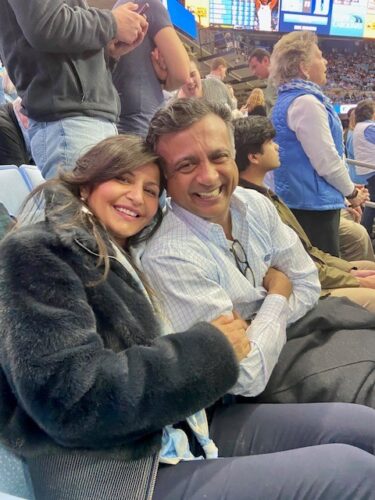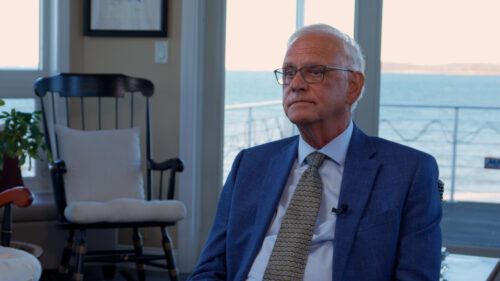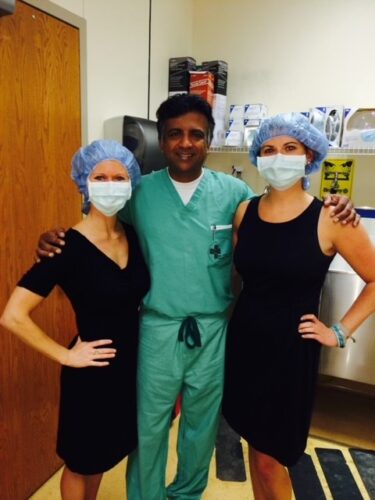By Joce Sterman and Daniela Molina
InvestigateTV — After decades in medicine, it seemed there wasn’t a problem or complication Dr. Henry Patel couldn’t overcome. A specialist in implanting pacemakers and defibrillators in complicated cases, Patel’s gift for silently performing what looked like medical miracles had earned him a nickname around the hospital: “The Ninja”.
“He got his name because he could come in and do the impossible,” said Shital Patel, his wife of nearly 30 years.
Patel may have been a stealth operator in the operating room, but for the North Carolina cardiologist and electrophysiologist, those skills were of no use when he went under the knife.

Dr. Henry Patel and his wife, Shital, attend a basketball game before his passing in 2020 (Courtesy of the Patel family).
On July 30, 2020, with his wife, Shital, by his side, he walked into the Wilmington clinic of Dr. Mark Austin, for what she said was supposed to be a simple, routine dental implant procedure.
Medical and state disciplinary records obtained by InvestigateTV show the surgery began without a problem, with two dental assistants chairside as Austin sedated Patel using Ketamine, Propofol and other IV drugs. As the procedure began to wrap up, Patel’s oxygen levels and heart rate dropped.
After asking repeatedly why she had not been summoned to recovery to see her husband, Mrs. Patel said she tried to push her way out of the waiting room and was immediately stopped by staffers who told her that her husband was in cardiac arrest.
“They’re like, ‘Don’t worry, we have a crash cart. We’re working on him’. And I’m like, ‘But what could have happened? Is he breathing?’” Mrs. Patel said.
When EMS arrived 20 minutes after the crisis began, Patel was not breathing. The 53-year-old had no pulse. But records from the state dental board show the dentist involved had made no attempts at CPR and the team failed to successfully carry out several other lifesaving measures.
Paramedics were able to bring Dr. Patel back to life, but he was left gravely ill. He died three days later from irreversible injuries caused by a lack of oxygen to his brain.
Patel’s colleagues contacted the North Carolina State Board of Dental Examiners, calling for an investigation. Following their inquiry, Dr. Mark Austin’s license was permanently surrendered in August 2021. Austin and his attorney were repeatedly contacted by InvestigateTV. Neither provided comment for this story.
“It makes me so mad because Henry’s death was preventable. Absolutely preventable. I want people to know that,” Mrs. Patel said. “Henry died because the people who were looking after him in that room, in that office, were not trained. They didn’t even know my husband didn’t have a pulse.”
Through Henry’s death, Mrs. Patel learned something stunning. Dentists use vastly different standards than physicians when it comes to anesthesia. “No other medical field allows this. We call it the medical model. The only people who don’t follow it and they’re allowed not to follow it, are dentists,” she said.
Guidelines recommend second highly skilled provider assist with dental surgery
The medical model Mrs. Patel is referring to is likely what you’ve seen if you’ve been deeply sedated or given general anesthesia in a hospital or surgery center.
Under that model, a physician or certified registered nurse anesthetist, also known as a CRNA, administers the anesthesia and monitors your vital signs while another provider handles the procedure. That way there’s skilled backup available if a patient stops breathing or experiences other life-threatening complications.
But at dentists’ offices, state regulations nationwide often allow dentists to do something other medical professionals generally do not: handle both anesthesia and surgery.
“I don’t think anybody can sedate somebody safely and perform a procedure at the same time. You have to concentrate on what you’re doing, right?,” said Dr. Charles Coté, professor emeritus of anesthesia at Harvard Medical School. “I honestly don’t see how you can do that and operate in the mouth and truly recognize when things have gotten out of hand.”

Dr. Charles Cote, professor emeritus of anesthesia at Harvard Medical School, helped develop some of the first guidelines for dental anesthesia and sedation (Photo by Scotty Smith, InvestigateTV).
Coté has spent decades looking at what happens when those worst-case scenarios occur during anesthesia, examining cases where dental patients have died or been seriously harmed. His clinical research, which began in the 1980s, helped create critical guidelines for dental sedation and anesthesia.
Those recommendations, which Coté says first targeted pediatric patients, have continued to evolve. He believes they improve patient safety when they’re followed.
But they’re just guidelines, not requirements dentists are obligated to follow.
“There’s no law that says they have to follow a guideline,” Coté told InvestigateTV. “It’s just common sense.”
The guidelines recommend that a dentist doing surgery should be accompanied by another sedation provider with specific airway rescue training. That individual, the guidelines recommend, can be another oral surgeon, an anesthesiologist, a CRNA or a dentist anesthesiologist, with both people specially trained for emergencies.
“When something goes wrong, there’s nobody else available to help them out. And when you think about it, when you have a rare event, then panic shuts in, and then your mind shuts down,” Coté said. “And if you’re not used to dealing with those things every day, that’s when things really go wrong.”
Despite support from major medical organizations, the guidelines are not universally implemented in states across the U.S., although advocates say they could save lives.
In fact, places such as California, New Hampshire, and North Carolina have lost battles when they tried to turn dental anesthesia recommendations into formal laws.
‘Tip of the iceberg’
Deaths can and do happen in the dentist’s chair, with a 2015 study published in the Journal of the American Dental Association estimating dental deaths and brain injuries linked to deep sedation and general anesthesia most likely exceed more than one a month.
InvestigateTV spent months researching dental anesthesia and sedation cases nationwide where patients died or were seriously hurt.
InvestigateTV made public records requests to every state in the nation, scoured media reports and dug through hundreds of publicly- available disciplinary files from state dental boards.
Our analysis of records from the last five years turned up at least 26 anesthesia deaths in 13 states.
“I suspect that’s the tip of the iceberg. There are many, many more that just don’t get reported or somehow are slipped under the rug and nothing happens,” Coté said.
A national examination of state laws governing so-called “adverse anesthesia events” done by InvestigateTV provides evidence of how adverse anesthesia cases could be missed or ignored.
At least 30 states have required that dentists report adverse events where patients are seriously hurt, hospitalized or killed to their dental board, including cases where patients were harmed in a case involving anesthesia.
InvestigateTV looked nationwide at laws related to the requirements for that reporting and found that:
- Some of those state laws have loopholes that don’t require reporting if someone has complications or dies days after the procedure.
- The number of reported cases isn’t tracked or counted by many states.
- Dentists don’t always report when required.
- Those reports are often confidential, with most states only making cases involving anesthesia deaths or injuries public when a dentist is disciplined.
Dental discipline records highlight mistakes in anesthesia cases, major failures in emergency response
Dental discipline records show mistakes made by dental providers in anesthesia cases across the country.
A patient in Arizona stopped breathing in a clinic where the oxygen system wasn’t even turned on. A Kansas dentist and staff kept pulling teeth, even when their sedated patient showed obvious signs of distress, with the dentist’s wife sent to buy oxygen mid-surgery when they realized there were no canisters in the office.
Records also show dentists who repeatedly delayed calls to 9-1-1 in a crisis, including one waiting as long as 35 minutes after a patient had critical breathing problems.
There were also numerous failures by dentists and their assistants when it comes to monitoring heart rates, oxygen levels and pulse readings, as well as mistakes with emergency response equipment like airway bag masks and intubation tubes that help restore breathing, with some dentists not using them at all.
And our analysis uncovered at least 14 deaths where dentists waited or never performed CPR, failed to provide adequate or timely emergency care, or administered lifesaving drugs to reverse the effects of anesthesia.
“If they wanted to, they could look at all these events and sort out what went wrong, when did it go wrong, how can we stop that from happening again?,” Coté questioned. “I would really love for the dental community to grab onto this as a societal issue to protect their patients and go back and look at what’s happening.”
Further research into adverse events could provide needed detail on the frequency of dental anesthesia deaths, injuries
Coté says an analysis of closed malpractice cases would give the dental community a more concrete sense of how often adverse anesthesia events happen.
InvestigateTV asked the American Association of Oral and Maxillofacial Surgeons, or AAOMS, about whether that sort of analysis or other research is being done.
The organization, which serves as a lobbying group, refused to answer questions about studying adverse events and other topics sent by InvestigateTV, even after asking for additional time to respond.
Several other major dental industry lobbying groups declined or ignored interview requests.
The American Dental Association, the lobbying group representing nearly 160,000 dental professionals across the country, was the only organization to respond, although it did not address staffing during surgery.
In a statement, a representative for the ADA said, “The administration of local anesthesia, sedation and general anesthesia is an integral part of dental practice. The American Dental Association (ADA) is committed to the safe and effective use of these modalities by appropriately educated and trained dentists. Dentists must comply with their state laws, rules and regulations and meet state-mandated educational requirements when providing sedation and anesthesia. State dental boards regulate dentists and oversee licensure and complaints in accordance with each state’s dental practice act. The ADA does not oversee or regulate dental practices as the organization is a voluntary, professional membership organization, not a regulatory body or licensing agency.”
Although no major national organizations would confirm they are actively doing research into the prevalence of adverse anesthesia events leading to death or injury, some states are beginning to examine the issue.
The Texas State Board of Dental Examiners recently formed a special advisory committee to review cases and make recommendations, streaming their meetings online. The committee reports indicate the group has already reviewed more than 70 dental cases involving sedation or anesthesia-related deaths or accidents, looking for trends.
Dr. Coté and other medical advocates want to see trends change when it comes to how dental surgeries are handled. They continue lobbying for that second, highly skilled provider to be part of dental surgery, rather than just a dental assistant.
Their goal is to always have two people with specific, high-level emergency skills monitoring procedures and at the ready to rescue an airway if a patient experiences an emergency.
An InvestigateTV analysis of state laws shows that’s not typical. Regulations are often vague when it comes to qualifications for those who assist with dental surgery.
In Alabama and Florida, the law says those assisting with dental surgery only need to be “appropriately trained.” State codes in Colorado and Maine require them to be “experienced in patient monitoring and documentation.” And in Delaware, the law says they just need to be “capable of reasonably handling procedures, problems and emergencies.”
“You can’t tell me a dental assistant knows how to do resuscitation, knows how to pass a breathing tube or knows how to do mask ventilation. You can have 10 people in that room, 20 people in the room. Who cares if they don’t have the skill set? They’re not going to successfully rescue,” Coté said.
People like Shital Patel, the ones left behind after a dental surgery disaster, say things need to change. She believes her husband’s case is an example of the kind of tragedy that could continue without intervention.
“Just imagine if they had been well-trained, knew what they were doing, or even had attempted CPR on Henry, he would have lived,” she said.

Doctor Henry Patel was a renowned cardiologist and electrophysiologist before his passing following dental surgery in 2020 (Photo courtesy of the Patel family).
The training of those involved in routine dental surgery, and how many qualified medical providers are in the room during procedures, was never something Mrs. Patel thought to ask about before her husband’s death. Now she’s a human megaphone to make sure others do.
“Silence won’t get me anywhere. Not with what I’m trying to do. I want to be heard,” she said.
Patel has never aspired to be a ninja. That was her husband’s job. And she says being stealth doesn’t serve the cause, or the industry she’s fighting.
“They know that I don’t give up,” Mrs. Patel said. “I will use every penny I have to keep fighting because no one should come back or come out of a dentist’s office as a widow.”
Olivia Oliver, Ashton Hackman, Julia Pearl, Rebekah Schultz, Lily Marks, Mitch Lierman, and Emma Luce with the Arnolt Center for Investigative Journalism at Indiana University contributed to the research for this report.


